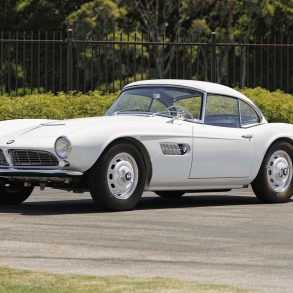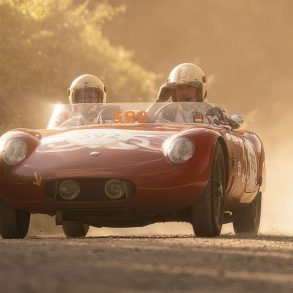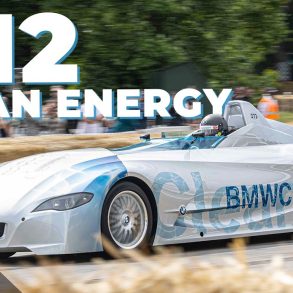Story by Will Silk

In the mid 1930s, BMW saw itself growing at a tremendous rate; both as an aviation engine component supplier, and especially in the realm of motorcycle technology, where BMW was further developing what has come to be known as its signature boxer twin engine for the two wheeled market. The car market for BMW was growing steadily for the German manufacturer from Munich, and in late 1935 the firm passed out literature to those select customers who were thought to have the ability to help the marque make a full entry into the world of sports car racing. The press was deliberately left out of the loop and the information that select “friends of the company” received was meant to be nothing more than an appetizer of sorts, for the main dish was yet to come.
On June 13, 1936 the world raised a very interested eye brow to the new BMW 328 that arrived to run at the Nurburgring race track’s annual Eifelrennen to be held the next day. The press, as was much of the public, were caught completely off guard by the sight of a beautiful new roadster with very elegant curves used throughout the design of the aluminum body. Selected to drive the car was none other than Ernst Henne, a factory two wheeled pilot and world record holder in motorcycle racing. Henne dominated the race that day, bringing the number 14 BMW 328 home in first place. Things were indeed looking very good for this new sports car from Bavaria.
The 328 kept up the winning ways it established at the 1936 Eifelrennen, much to the bewilderment of the European press and fans. This small sports roadster weighed in at 1,830lbs without a driver and rode on a steel ladder frame with 94 inches between the wheels. Under the sexy aluminum body work laid a drive train that was perhaps just as beautiful as the body work itself. The inline six cylinder engine gave the appearance that it was using over head cams when in fact it was using a masterpiece of pushrod engineering to actuate the valves. Carburetion was handled by three Solex down draught carburetors and power was rated at 80 horsepower at 5000 rpm. The 1,971cc six was backed by a four speed gearbox and suspension duties were left to a transverse leaf spring arrangement in the front and a live axle with leaf spring set up in the rear. Top speed of a production specification Type 328 was rated at 93mph.
Throughout 1937, BMW dominated the 2.0 liter class of sports car racing in Germany, but the personnel involved were now hungry to take their new little sports car abroad and to challenge the factory teams from competitors such as Alfa Romeo, Fiat, and Riley. With political relations growing colder between the German government and many of the other nations in Europe with each passing day, BMW sought a solid proving ground outside of their native land to test the Type 328. Benito Mussolini was in power just across the Alps in Italy, so arrangements were made to enter a team of 328s in the 1938 running of the classic Mille Miglia road race, one of the toughest proving grounds for any sports car.
The Mille Miglia was a race like no other on the planet. The course was almost unimaginable in that it literally ran through nearly the entire nation of Italy. The course began in Brescia, located in the central part of northern Italy. From there it followed public roads lined with walls of fist pumping, screaming Italian race fans; first moving east to Verona, and then turning south and moving towards Ferrara. Mille Miglia translated is 1000 Miles, and once at Ferrara you aren’t even a quarter of the way to the checkered flag!
You would continue from Ferrara to Ravenna on Italy’s east coast and proceed with your right foot on the floor all the way to Rome. Once in Rome, you would turn north and begin the trek back to Brescia, passing through Siena, Firenze, Bologna, and Modena before seeing the checkered flag. A race course like that of the classic Mille Miglia would be thought of as pure insanity in today’s day and age, but throughout the 1930s the Mille Miglia was regarded as one of the best proving grounds for any production sports car.
The 1938 race through Italy was divided into two sporting classes; the first was the national class for cars from Italy and the second was the international class for cars and drivers from outside the country. Provisions were made in both classes for supercharged and non-supercharged cars, and the smallest displacement allowed in the international class was for 2.0 liters, which suited the little BMW perfectly.
Four 328s took to the start line on April 3, 1938 being piloted by German, Italian, and English crews. Factory race director Ernst Loof looked after those cars as well as a private entry for the crew of Muhle-Eckart/Holzschuh, the latter of whom worked in the BMW sports car repairs department. Other class entries included cars from Fiat, Riley, and Aston Martin.
The 1938 race was run in ideal weather conditions and the first car left Brescia at 2:00 AM followed by the second car one minute later, the interval continuing until all starters were under way. The first 328 left the line at 4:30 AM with Schamburg-Lippe/Lurani in the cockpit. The other 328s followed suit shortly after and the little sports cars from Munich were now fully indulged in a fight of epic proportions in one of the most mythical road races the world has ever come to know.
To BMW’s surprise, its class rivals all exited the race prior to reaching Rome, the halfway point of the race. This, however, didn’t slow the BMW entries one bit, as they then waged an all out war on the larger displacement sports cars running in the field. Twelve hours later in Brescia, and a few of the larger displacement cars were beginning to cross the line when to everyone’s surprise a BMW 328 came racing across the finish for eighth place and winning the 2 liter class. The winning car was piloted by the British crew of Fane and James and was entered under the Frazier Nash banner. Despite the race being cut short by Benito Mussolini in the wake of a tragic accident that took the life of several spectators; BMW 328s left Italy finishing 8th, 10th, 11th, and 12th overall and sweeping the 2.0 liter class for international sports cars.
Due to the casualties within the spectator ranks during the 1938 Mille Miglia, the classic race was not held the following spring in Italy. Though war clouds continued to grow darker as 1939 went on, BMW began to develop a coupe version of the 328 after studies showed that there was little use in attempting to further remove any weight from the car, as German engineers were content that they already achieved an excellent platform that combined light weight and structural rigidity. Work also continued to further develop the six cylinder engine and boost horsepower to a level closer to that of their competitors. However, the engine already proved to be fairly efficient and only small gains were expected to be brought about. This left the beautiful aluminum body work of the 328 as the only possible way to gain the precious speed needed to continue the 328’s winning tradition that began in 1936. The original body was indeed beautiful to the eye, but proved to be about as aerodynamic as a barn door once Professor Wunibald Kamm entered the program. Dr. Kamm was one of Germany’s leading aerodynamicists in the late 1930s; however his work is more widely known to those of us here in North America for one of the most fierce some looking road race cars to ever turn a wheel in anger, the 1952 Cunningham C4RK.
Work for a streamlined body was then handed to Rudolf Flemming, who was a major player in the design of the 328. The car was to have a closed roof and weight was to be kept to the bare minimum. Flemming set about building a space frame to fit the 328 chassis and drape it in light aluminum coupe body work. The body was made by Eisenach and quality was not to the level that was anticipated. Internally, this car was dubbed project AM 1007, and despite the speeds that the car was able to achieve, the sacrifice of stability was deemed to great and the project was held back by the factory until proper development could yield a better result.
In the meantime, a national team was formed in Germany called the NSKK. The NSKK (National Socialist Motoring Corps) was formed to take Germany’s racing efforts abroad and fly the German flag at the world’s most prestigious race events racing BMW 328s. BMW’s hand was forced to provide the team with cars and equipment, but when word got out about a new aerodynamic coupe, the NSKK demanded obtaining one immediately. BMW viewed the NSKK as a rival team and was unwilling to cooperate leaving the NSKK to go to Italy and contract Carrozzeria Touring to build a body for one of their 328s.
Touring was able to build an aerodynamic body for one of the NSKK’s 328 chassis in just four weeks, basing the project on a similar program that they had earlier assisted Alfa Romeo with. In traditional Italian fashion for the time, no wind tunnel testing was used as it was simply not available. Touring’s builders relied on empirical methods and plain instinct to guide them in shaping and crafting a body for the NSKK team’s 328.
The Touring Coupe, as the NSKK’s car became known, debuted at the Le Mans 24 Hour Race in June 1939. Once again, in spectacular 328 style, the Touring Coupe finished fifth overall and won the 2.0 liter sports car class in the hands of Prince Schaumburg and BMW engineer Hans Wencher. While the result was met with great joy amongst the German fans, back in Munich the news was not as happily received.
Professor Kamm continued to assist BMW with further development of Project AM 1007 and the team discovered that the body did not properly fit the chassis. Wilhelm Meyerhuber and his designers were then asked to draw a new streamlined body for the program, now known as Project AM 1008.
Straight line stability was a problem with AM 1007. This was cured in the AM 1008 program with the debut of a new space frame chassis, made of super-light Elektron, and weighing just 66 pounds, despite being stretched 20 centimeters. Coupled with the new bodywork developed by Dr. Kamm, the new car was 44 pounds lighter than the Touring Coupe, although it was larger in overall size. The work on the Kamm Coupe paid off in that it had less drag than the Touring Coupe, with a Cd of 0.25 as opposed to the Italian model’s 0.35. The Kamm Coupe also set a record top speed of 143mph.
While work on the aero-coupe concepts continued, development was still ongoing in regards to the open cockpit variant. It should be noted that in Germany at the time of the late 1930s, a sports car was defined as having no roof, and only cars that were constructed as roadsters were eligible to be entered into domestic sports car races.
Wilhelm Meyerhuber and his team set about designing a streamlined body of open cockpit construction to take the 328 into the next stage of its racing career. In the fall of 1939, after wind tunnel tests in Stuttgart, the team constructed a space frame and attached it to the previous year’s Mille Miglia winner. The profound edging used in the styling of the aerodynamic roadster earned the car the nickname of “Trouser Crease” Roadster. Local race hero Uli Richter sorted the new roadster on the autobahn outside of Munich while another 328 chassis was prepared to receive a space frame and aerodynamic bodywork. Willy Huber, a master metal worker for BMW was then given the two cars to take to Milan in the spring of 1940 to finish the construction of the roadsters and prepare of the 1940 running of the Mille Miglia.






The 1940 running of the Mille Miglia is still disputed by most sports racing aficionados to this day as to whether or not it should be classed as an official running of the race due to the dramatic reduction in the size of the course by the Mussolini regime. For 1940, racers would still start from Brescia and race to Cremona, then Mantua, before returning to Brescia. This circuit would be lapped nine times, each lap a distance of roughly 62 miles. While traditionalists still cringe to mention this running of the iconic Italian race, it’s important to note that the Italian fans were overly enthralled with the new layout as they now were able to see the cars speed by nine times instead of only once.
The entry list for the 1940 race was, as usual, dominated by red cars. Of particular note however, was the debut of two beautiful new roadsters that somewhat resembled an Alfa Romeo of sorts. These sleek red machines were the entry of Enzo Ferrari, who had just separated from the Alfa Romeo team and began his own company under the AAC banner (Auto Avio Costruzioni). The car was dubbed the Tipo 815; while both entries failed to finish, it was clear that Mr. Ferrari intended fully to proceed on his own terms in race car construction.
Two entries from the French Delage company made the start and both were piloted by Italian crews. Five BMW entries, all in German Racing Silver, arrived to take part in the action that spring. The NSKK team was awarded the drive of three streamlined roadsters; with piloting being handed to Wencher and Scholz (car number 71), Briem and Richter (car number 72), and Brudes and Roese (car number 73). The ONS team from Germany handled the sleek racing coupes, with von Hanstein and Baumer piloting the Italian-bodied Touring Coupe, and Count Cernushi and Franco Cortese of Italy handling the factory BMW built Kamm Coupe.
At 6:40 AM on the morning of April 28, 1940; von Hanstein and Baumer accelerated away from the start line in Brescia. Cars departed from the start line in one minute intervals in typical Mille Miglia fashion, and the four remaining BMWs soon followed. From the moment they took the green flag, the duo of von Hanstein/Baumer were flying, putting in a lap of unprecedented pace, with the only competition coming from a French Delage which was behind by one and a half minutes.
By the time the second lap came around, both BMW coupes were leading, with the roadsters still in the top ten and delivering a heavy fight of unforeseen ferociousness to the fastest teams of Italy. On lap 7 the Kamm Coupe, piloted by Cernushi/Cortese was forced to retire; succumbing to carburetor and oil supply problems. The crew was deeply disappointed, as it was the Kamm Coupe which topped the Touring Coupe in all pre-race tests and was favored by the factory to do better than the Italian bodied car.
Lap 9 saw the Touring Coupe flying and still with von Hanstein at the wheel, as the pair thought it best to keep the hammer down as long as they could in order to secure a comfortable lead. Von Hanstein set a speed record at an average speed of 108mph just before the car slowed to allow Baumer to take the wheel a few miles from the finish line. So it was with Walter Baumer at the helm that BMW would take its first true overall international win that day in April, 1940.





Celebrations were subdued, however, as the Italian crowd and much of the press was caught completely by surprise seeing the little German coupe fly across the finish line first, beating the Italian giants, many of which had power plants in the range of 3.0 liters. The BMW roadsters finished 3rd, 5th, and 6th overall; with the Kamm Coupe bowing out during lap 7 holding a very strong 2nd position at the time.
With the Second World War in full swing by the spring of 1940, the returning BMW teams were greeted by a royal reception at the Odeonsplatz und Residenz back home in Munich. This would be the last great party celebrating any sort of motorsports victory as racing was then terminated and efforts were solely put forth for fighting the war. It would be seven years until the world would once again experience the great Mille Miglia road race of Italy. This time the race would return to a somewhat more traditional course layout. Despite the fact that some in the sports car realm may not fully recognize the victory BMW secured in the 1940 Mille Miglia, one must certainly admit fully that the little sports cars from Munich fully deserve to be recognized on their 70th anniversary of their victory for beating cars on the open roads of Italy that were far greater in size and power than what the boys at BMW had to work with on that April day in Italy, 1940.
[Source: BMW AG]











I wasn’t aware of these events – thanks!